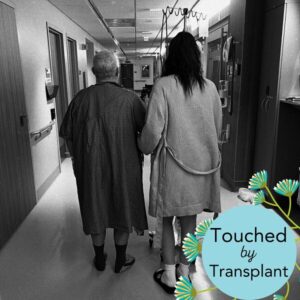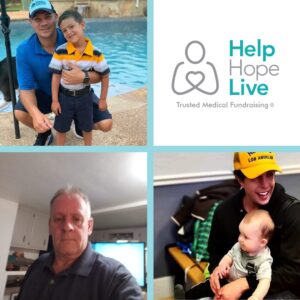I once wondered if I would make it to age 30; I’m 38 now. I am Nicole Seefeldt, and I have been living with the chronic lung disease lymphangioleiomyomatosis – more commonly known as LAM – for more than 10 years.

Nicole after an improv workshop
My Story
In 2010, I began having a yearly talk with my doctor about a (double lung) transplant. I was feeling fine at the time with my LAM, but my doctor knew it was a good idea to bring it up as soon as possible to prepare me. At every session, the doctor would check my oxygen numbers to determine whether or not getting evaluated for a transplant would be in my immediate future.
For me to stay on my insurance plan, I had to work 30 hours a week. That was a significant reduction to my original work hours, but my energy levels became so unpredictable, I could only work for an hour or two on a good day before needing a break. I was planning to work up until my transplant evaluation, possibly part time. But my doctor advised me to quit working in July 2015 when I experienced a rapid drop in my oxygen levels and had to be taken to a hospital immediately. My doctors still don’t know what caused the desaturation, but since then, I have needed oxygen 24/7.
I had to talk with my parents and friends to tell them I would need their support and a dedicated caregiver to help me through the process. My best friend stepped up right away! Luckily, support is one thing I was not lacking as I began to prepare for transplant: I am well-connected via social media, volunteer work and improv comedy, which I like to do in my downtime.

Nicole set a goal of $20,000 when she started fundraising
When I started fundraising with HelpHOPELive, I set a goal of $20,000 in order to cover the expenses I would be responsible for when the time came for my transplant. The $20,000 would also allow me to receive two challenge grants from HelpHOPELive.
HelpHOPELive: Contact your Fundraising Coordinator today to learn more about how to get a challenge grant when you reach a fundraising milestone.
Since last year, some of my disability insurance benefits have been decreased, changed or even eliminated, so my out-of-pocket expenses may continue to increase, especially the temporary housing costs I’ll face during my post-transplant recovery period (I don’t meet the distance requirements set forth by my insurance provider to be covered or reimbursed for this expenses). That’s why fundraising is an essential part of this journey.
It’s easy to feel shame and guilt when you have to stop working because of an illness. Fundraise to take some of the pressure off for you and your family and free up your expenses to stay afloat until you can get to a healthier place. It’s important to be transparent if you’re struggling. You have to say, look, this is why I need this money: I am on X medications that cost me X per year; my insurance premiums cost me X per month, even with Medicaid. People understand that as long as you give them something quantifiable.
How I Keep Hope Alive
There are a few things I do to fight back while I wait for a life-changing transplant:
- Keeping myself healthy. My exercise levels are back to a healthy level so I can do a few light weights and other things to build up my upper body for transplant. I need my upper body to be strong enough to rebound and heal after the transplant takes place. There were times in the past where I wouldn’t feel good and would get frustrated with exercise. But exercise is one thing I feel like I can control, and my lungs feel much clearer when I do it. It’s the one gift I can give my medical team to fight back.
- Staying patient. Living with a chronic illness and facing your own mortality puts your priorities in order in terms of what you value. Ultimately you learn that it’s rough, but it’s not insurmountable. You find your ways to cope and reconcile things. You have to at least in some aspect use whatever you have to fight back and to hang in the fight. I’m empowering myself and other people to make life more manageable. Maybe the research is too late for me but it might not be too late for someone else.
Nicole is fundraising with HelpHOPELive for LAM-related expenses, including a limited period of lost wages as she remains on long-term disability, COBRA insurance payments, oxygen rentals and other uninsured costs.
I once wondered if I would make it to age 30; I’m 38 now. I am Nicole Seefeldt, and I have been living with the chronic lung disease lymphangioleiomyomatosis – more commonly known as LAM – for more than 10 years.

My Story
In 2010, I began having a yearly talk with my doctor about a (double lung) transplant. I was feeling fine at the time with my LAM, but my doctor knew it was a good idea to bring it up as soon as possible to prepare me. At every session, the doctor would check my oxygen numbers to determine whether or not getting evaluated for a transplant would be in my immediate future.
For me to stay on my insurance plan, I had to work 30 hours a week. That was a significant reduction to my original work hours, but my energy levels became so unpredictable, I could only work for an hour or two on a good day before needing a break. I was planning to work up until my transplant evaluation, possibly part time. But my doctor advised me to quit working in July 2015 when I experienced a rapid drop in my oxygen levels and had to be taken to a hospital immediately. My doctors still don’t know what caused the desaturation, but since then, I have needed oxygen 24/7.
I had to talk with my parents and friends to tell them I would need their support and a dedicated caregiver to help me through the process. My best friend stepped up right away! Luckily, support is one thing I was not lacking as I began to prepare for transplant: I am well-connected via social media, volunteer work and improv comedy, which I like to do in my downtime.

When I started fundraising with HelpHOPELive, I set a goal of $20,000 in order to cover the expenses I would be responsible for when the time came for my transplant. The $20,000 would also allow me to receive two challenge grants from HelpHOPELive.
HelpHOPELive: Contact your Fundraising Coordinator today to learn more about how to get a challenge grant when you reach a fundraising milestone.
Since last year, some of my disability insurance benefits have been decreased, changed or even eliminated, so my out-of-pocket expenses may continue to increase, especially the temporary housing costs I’ll face during my post-transplant recovery period (I don’t meet the distance requirements set forth by my insurance provider to be covered or reimbursed for this expenses). That’s why fundraising is an essential part of this journey.
It’s easy to feel shame and guilt when you have to stop working because of an illness. Fundraise to take some of the pressure off for you and your family and free up your expenses to stay afloat until you can get to a healthier place. It’s important to be transparent if you’re struggling. You have to say, look, this is why I need this money: I am on X medications that cost me X per year; my insurance premiums cost me X per month, even with Medicaid. People understand that as long as you give them something quantifiable.
How I Keep Hope Alive
There are a few things I do to fight back while I wait for a life-changing transplant:
- Keeping myself healthy. My exercise levels are back to a healthy level so I can do a few light weights and other things to build up my upper body for transplant. I need my upper body to be strong enough to rebound and heal after the transplant takes place. There were times in the past where I wouldn’t feel good and would get frustrated with exercise. But exercise is one thing I feel like I can control, and my lungs feel much clearer when I do it. It’s the one gift I can give my medical team to fight back.
- Staying patient. Living with a chronic illness and facing your own mortality puts your priorities in order in terms of what you value. Ultimately you learn that it’s rough, but it’s not insurmountable. You find your ways to cope and reconcile things. You have to at least in some aspect use whatever you have to fight back and to hang in the fight. I’m empowering myself and other people to make life more manageable. Maybe the research is too late for me but it might not be too late for someone else.
Nicole is fundraising with HelpHOPELive for LAM-related expenses, including a limited period of lost wages as she remains on long-term disability, COBRA insurance payments, oxygen rentals and other uninsured costs.











